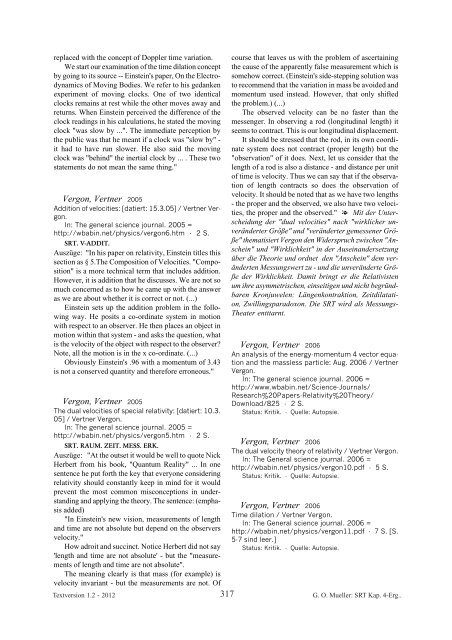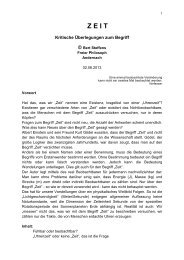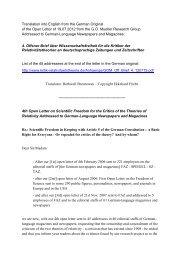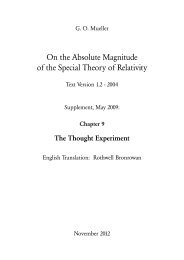2394 weitere kritische Veröffentlichungen - Kritische Stimmen zur ...
2394 weitere kritische Veröffentlichungen - Kritische Stimmen zur ...
2394 weitere kritische Veröffentlichungen - Kritische Stimmen zur ...
Erfolgreiche ePaper selbst erstellen
Machen Sie aus Ihren PDF Publikationen ein blätterbares Flipbook mit unserer einzigartigen Google optimierten e-Paper Software.
eplaced with the concept of Doppler time variation.<br />
We start our examination of the time dilation concept<br />
by going to its source -- Einstein's paper, On the Electrodynamics<br />
of Moving Bodies. We refer to his gedanken<br />
experiment of moving clocks. One of two identical<br />
clocks remains at rest while the other moves away and<br />
returns. When Einstein perceived the difference of the<br />
clock readings in his calculations, he stated the moving<br />
clock "was slow by ...". The immediate perception by<br />
the public was that he meant if a clock was "slow by" -<br />
it had to have run slower. He also said the moving<br />
clock was "behind" the inertial clock by ... . These two<br />
statements do not mean the same thing."<br />
Vergon, Vertner 2005<br />
Addition of velocities: [datiert: 15.3.05] / Vertner Vergon.<br />
In: The general science journal. 2005 =<br />
http://wbabin.net/physics/vergon6.htm - 2 S.<br />
SRT. V-ADDIT.<br />
Auszüge: "In his paper on relativity, Einstein titles this<br />
section as § 5.The Composition of Velocities. "Composition"<br />
is a more technical term that includes addition.<br />
However, it is addition that he discusses. We are not so<br />
much concerned as to how he came up with the answer<br />
as we are about whether it is correct or not. (...)<br />
Einstein sets up the addition problem in the following<br />
way. He posits a co-ordinate system in motion<br />
with respect to an observer. He then places an object in<br />
motion within that system - and asks the question, what<br />
is the velocity of the object with respect to the observer?<br />
Note, all the motion is in the x co-ordinate. (...)<br />
Obviously Einstein's .96 with a momentum of 3.43<br />
is not a conserved quantity and therefore erroneous."<br />
Vergon, Vertner 2005<br />
The dual velocities of special relativity: [datiert: 10.3.<br />
05] / Vertner Vergon.<br />
In: The general science journal. 2005 =<br />
http://wbabin.net/physics/vergon5.htm - 2 S.<br />
SRT. RAUM. ZEIT. MESS. ERK.<br />
Auszüge: "At the outset it would be well to quote Nick<br />
Herbert from his book, "Quantum Reality" ... In one<br />
sentence he put forth the key that everyone considering<br />
relativity should constantly keep in mind for it would<br />
prevent the most common misconceptions in understanding<br />
and applying the theory. The sentence: (emphasis<br />
added)<br />
"In Einstein's new vision, measurements of length<br />
and time are not absolute but depend on the observers<br />
velocity."<br />
How adroit and succinct. Notice Herbert did not say<br />
'length and time are not absolute' - but the "measurements<br />
of length and time are not absolute".<br />
The meaning clearly is that mass (for example) is<br />
velocity invariant - but the measurements are not. Of<br />
course that leaves us with the problem of ascertaining<br />
the cause of the apparently false measurement which is<br />
somehow correct. (Einstein's side-stepping solution was<br />
to recommend that the variation in mass be avoided and<br />
momentum used instead. However, that only shifted<br />
the problem.) (...)<br />
The observed velocity can be no faster than the<br />
messenger. In observing a rod (longitudinal length) it<br />
seems to contract. This is our longitudinal displacement.<br />
It should be stressed that the rod, in its own coordinate<br />
system does not contract (proper length) but the<br />
"observation" of it does. Next, let us consider that the<br />
length of a rod is also a distance - and distance per unit<br />
of time is velocity. Thus we can say that if the observation<br />
of length contracts so does the observation of<br />
velocity. It should be noted that as we have two lengths<br />
- the proper and the observed, we also have two velocities,<br />
the proper and the observed." � Mit der Unterscheidung<br />
der "dual velocities" nach "wirklicher unveränderter<br />
Größe" und "veränderter gemessener Größe"<br />
thematisiert Vergon den Widerspruch zwischen "Anschein"<br />
und "Wirklichkeit" in der Auseinandersetzung<br />
über die Theorie und ordnet den "Anschein" dem veränderten<br />
Messungswert zu - und die unveränderte Größe<br />
der Wirklichkeit. Damit bringt er die Relativisten<br />
um ihre asymmetrischen, einseitigen und nicht begründbaren<br />
Kronjuwelen: Längenkontraktion, Zeitdilatation,<br />
Zwillingsparadoxon. Die SRT wird als Messungs-<br />
Theater entttarnt.<br />
Vergon, Vertner 2006<br />
An analysis of the energy-momentum 4 vector equation<br />
and the massless particle: Aug. 2006 / Vertner<br />
Vergon.<br />
In: The general science journal. 2006 =<br />
http://www.wbabin.net/Science-Journals/<br />
Research%20Papers-Relativity%20Theory/<br />
Download/825 - 2 S.<br />
Status: Kritik. - Quelle: Autopsie.<br />
Vergon, Vertner 2006<br />
The dual velocity theory of relativity / Vertner Vergon.<br />
In: The General science journal. 2006 =<br />
http://wbabin.net/physics/vergon10.pdf - 5 S.<br />
Status: Kritik. - Quelle: Autopsie.<br />
Vergon, Vertner 2006<br />
Time dilation / Vertner Vergon.<br />
In: The General science journal. 2006 =<br />
http://wbabin.net/physics/vergon11.pdf - 7 S. [S.<br />
5-7 sind leer.]<br />
Status: Kritik. - Quelle: Autopsie.<br />
Textversion 1.2 - 2012 317<br />
G. O. Mueller: SRT Kap. 4-Erg..





